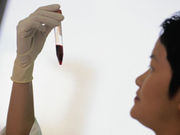Greater co-occurrence seen in children with T1D family history, HLA-DR3/4, and SNP rs3184504
TUESDAY, Oct. 10, 2017 (HealthDay News) — Co-occurrence of type 1 diabetes (T1D) and celiac disease (CD) autoimmunities significantly exceeds the expected rate, according to a study published online Oct. 10 in Pediatrics.
William Hagopian, M.D., Ph.D., from the Pacific Northwest Research Institute in Seattle, and colleagues enrolled 8,676 children at high genetic risk of T1D and CD and analyzed data from 5,891 for a median follow-up of 66 months. The authors analyzed demographic factors and human leukocyte antigen (HLA)-DR-DQ, as well as genotypes for HLA-DPB1 and five non-HLA loci conferring risk of T1D and CD. From age 3 to 48 months, development of persistent islet autoantibodies (IAs) and tissue transglutaminase autoantibodies (tTGAs) and clinical disease was assessed quarterly.
The researchers found that IAs alone, tTGAs alone, and both appeared in 367, 808, and 90 children, respectively, with co-occurrence significantly exceeding the expected rate. Usually, but not always, IAs preceded tTGAs. Increased risk of tTGAs was seen with IAs preceding tTGAs (hazard ratio, 1.48). Children with a T1D family history, HLA-DR3/4, and single-nucleotide polymorphism rs3184504 at SH2B3 had significantly greater co-occurrence after adjustment for country, sex, family history, and all other genetic loci (hazard ratios, 2.8, 1.94, and 1.53). All analyzed factors did not fully account for observed co-occurrence.
“Co-occurrence is greater than explained by demographic factors and extensive genetic risk loci, indicating that shared environmental or pathophysiological mechanisms may contribute to the increased risk,” the authors write.
Copyright © 2017 HealthDay. All rights reserved.








